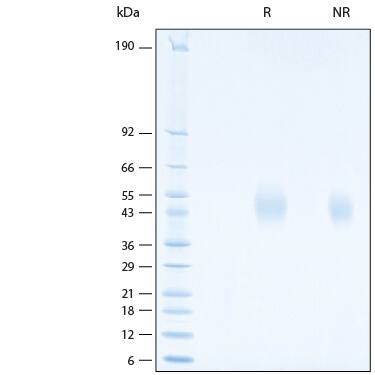Recombinant Human IL-18 BPa His-tag Protein, CF
R&D Systems, part of Bio-Techne | Catalog # 11236-BP

Key Product Details
Product Specifications
Source
Thr31-Gly194, with a C-terminal 6-His tag
Purity
Endotoxin Level
N-terminal Sequence Analysis
Predicted Molecular Mass
SDS-PAGE
Activity
Scientific Data Images for Recombinant Human IL-18 BPa His-tag Protein, CF
Recombinant Human IL-18 BPa His-tag Protein Bioactivity.
Measured by its ability to inhibit the IL-18-induced response of KG-1 Human Acute Myelogenous Leukemia cells . The ED50 for this effect is 5.00-30.0 ng/mL in the presence of 20 ng/mL of Recombinant Human IL-18.Recombinant Human IL-18 BPa His-tag Protein SDS-PAGE.
2 μg/lane of Recombinant Human IL-18 BPa His-tag Protein (Catalog # 11236-BP) was resolved with SDS-PAGE under reducing (R) and non-reducing (NR) conditions and visualized by Coomassie® Blue staining, showing bands at 44-51 kDa.Formulation, Preparation and Storage
11236-BP
| Formulation | Lyophilized from a 0.2 μm filtered solution in PBS with trehalose. |
| Reconstitution | Reconstitute at 500 μg/mL in PBS. |
| Shipping | The product is shipped at ambient temperature. Upon receipt, store it immediately at the temperature recommended below. |
| Stability & Storage | Use a manual defrost freezer and avoid repeated freeze-thaw cycles.
|
Background: IL-18 BPa
IL-18 Receptor alpha (IL-18 Ra), also known as IL-18 R1, IL-1 R5, and IL-1 Rrp, is a transmembrane component of the IL-18 Receptor (1). It associates with IL‑18 Rb/IL‑1 R7 to form the high affinity receptor complex for IL-18 and confer cellular responsiveness to IL-18 (2, 3). IL-18 is a member of the IL-1 family of cytokines and shares numerous immunoregulatory functions with IL-12. Mature human IL-18 Ra consists of a 308 amino acid (aa) extracellular domain (ECD) with three immunoglobulin-like domains, a 21 aa transmembrane segment, and a 191 aa cytoplasmic domain (4). Within the ECD, human IL-18 Ra shares 56% aa sequence identity with mouse and rat IL-18 Ra. IL-18 Ra is widely expressed on epithelial cells as well as on B cells, NK cells, CD4+ and CD8+ T cells, and dendritic cells (5-8). Signaling through the IL-18 receptor promotes a Th1 biased immune response and NK cell cytolytic activity (6, 7, 9-11). It also contributes to cigarette smoke-induced airway inflammation and epithelial damage (12).
References
- Dinarello, C.A. et al. (2013) Front. Immunol. 4:289.
- Torigoe, K. et al. (1997) J. Biol. Chem. 272:25737.
- Born, T.L. et al. (1998) J. Biol. Chem. 273:29445.
- Parnet, P. et al. (1996) J. Biol. Chem. 271:3967.
- Kunikata, T. et al. (1998) Cell Immunol. 189:135.
- Smeltz, R.B. et al. (2001) J. Exp. Med. 194:143.
- Chan, W.L. et al. (2001) J. Immunol. 167:1238.
- Kaser, A. et al. (2004) Blood 103:648.
- Tomura, M. et al. (1998) J. Immunol. 160:3759.
- Yoshimoto, T. et al. (1998) J. Immunol. 161:3400.
- Hyodo, Y. et al. (1999) J. Immunol. 162:1662.
- Kang, M.J. et al. (2007) J. Immunol. 178:1948.
Long Name
Alternate Names
Gene Symbol
UniProt
Additional IL-18 BPa Products
Product Documents for Recombinant Human IL-18 BPa His-tag Protein, CF
Product Specific Notices for Recombinant Human IL-18 BPa His-tag Protein, CF
For research use only

